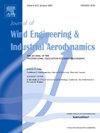Approximating wind speed probability distributions around a building by mixture weibull distribution with the methods of moments and L-moments
IF 4.2
2区 工程技术
Q1 ENGINEERING, CIVIL
Journal of Wind Engineering and Industrial Aerodynamics
Pub Date : 2025-02-01
DOI:10.1016/j.jweia.2024.106001
引用次数: 0
Abstract
Wind speed probability distribution functions (PDFs) are crucial for evaluating urban wind environments. While previous studies have used unimodal distribution functions to model PDFs, bimodal patterns are also observed in urban areas. To more accurately model unimodal and bimodal PDFs, this study assessed the applicability of the mixture Weibull distribution (2W2W). The performance of the two-parameter Weibull distribution (2W) was also analyzed for comparison. Three parameter estimation methods (method of moments (MM), method of L-moments (LM), and maximum likelihood method (ML)) were applied to wind speed data of an isolated building case from a LES database. It was found that L-moments show non-linear relationships with moments, but with smaller magnitudes. 2W2W outperforms 2W in estimating both moments and L-moments, especially for higher-order statistics. 2W2W has the potential to better capture both unimodal and bimodal distributions compared to 2W. While 2W2W generally outperforms 2W under MM, noticeable oscillations were observed at some points. Although ML is the most accurate method at most points, LM still outperforms ML at specific locations based on both 2W and 2W2W. This study is expected to offer valuable insights into modeling PDFs for urban wind environments.
求助全文
约1分钟内获得全文
求助全文
来源期刊
CiteScore
8.90
自引率
22.90%
发文量
306
审稿时长
4.4 months
期刊介绍:
The objective of the journal is to provide a means for the publication and interchange of information, on an international basis, on all those aspects of wind engineering that are included in the activities of the International Association for Wind Engineering http://www.iawe.org/. These are: social and economic impact of wind effects; wind characteristics and structure, local wind environments, wind loads and structural response, diffusion, pollutant dispersion and matter transport, wind effects on building heat loss and ventilation, wind effects on transport systems, aerodynamic aspects of wind energy generation, and codification of wind effects.
Papers on these subjects describing full-scale measurements, wind-tunnel simulation studies, computational or theoretical methods are published, as well as papers dealing with the development of techniques and apparatus for wind engineering experiments.

 求助内容:
求助内容: 应助结果提醒方式:
应助结果提醒方式:


